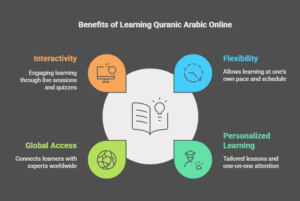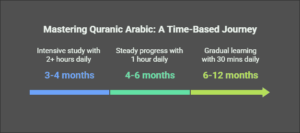Learning to read Quranic Arabic is a spiritual journey that connects Muslims directly to the words of Allah (SWT). Since the Quran was revealed in Arabic, understanding and reciting it in its original language deepens faith, enhances Tajweed skills, and brings immense rewards.
With the rise of online learning, mastering Quranic Arabic is now more accessible, flexible, and effective than ever. Whether you’re a beginner or someone looking to improve fluency, this guide will help you find the best approach to learning Quranic Arabic online.
Why Learning Quranic Arabic is Important
📖 The Prophet Muhammad (ﷺ) said:
“The best among you are those who learn the Quran and teach it.” (Sahih al-Bukhari 5027)
✅ Direct Connection with Allah – Understand the Quran in its original language.
✅ Correct Pronunciation & Tajweed – Avoid mistakes that may change meanings.
✅ Strengthens Focus in Salah – Improve concentration and devotion in prayers.
✅ Preserves Islamic Heritage – Keeps Quranic language alive for future generations.
✅ Multiplies Rewards – Every letter recited brings 10 rewards (Tirmidhi 2910).
💡 Tip: Even if Arabic isn’t your first language, learning Quranic Arabic is easier than you think with structured online courses.
Best Way to Learn to Read Quranic Arabic Online

1. Start with Noorani Qaida for a Strong Foundation
📌 Noorani Qaida is a beginner’s guide to Quranic Arabic reading.
✔️ Teaches the Arabic alphabet, vowels, and basic pronunciation rules.
✔️ Helps learners recognize letters and their correct articulation (Makharij).
✔️ Builds confidence before starting Quran recitation.
💡 Tip: Completing Noorani Qaida before moving to Quran reading makes learning faster and more accurate.
2. Master Tajweed Rules for Proper Pronunciation
📌 Tajweed is the art of reciting the Quran correctly.
✔️ Ensures each Arabic letter is pronounced properly.
✔️ Teaches rules like Ikhfa, Madd, Qalqala, and Ghunnah.
✔️ Helps avoid errors that could change meanings.
💡 Tip: Listen to expert reciters (Qaris) and repeat after them to perfect Tajweed.
3. Choose the Right Online Quran Course
📌 Different learners have different needs. Find a course that matches your level:
✔️ Beginner Course – Focuses on Arabic letters, vowels, and simple words.
✔️ Intermediate Course – Enhances reading fluency and Tajweed application.
✔️ Advanced Course – Covers Quran memorization (Hifz) and Tafseer (interpretation).
💡 Tip: One-on-one classes with a tutor ensure faster progress than group sessions.
4. Use Interactive Tools & Technology
📌 Online learning platforms offer various tools to enhance Quranic Arabic reading.
✔️ Quran Apps: Provide audio recitations for practice.
✔️ Video Lessons: Show correct tongue and mouth positions for Tajweed.
✔️ AI Speech Recognition: Corrects pronunciation mistakes.
✔️ Flashcards & Games: Make learning fun and engaging.
📌 Recommended Apps:
📱 Tajweed Quran – Learn rules with interactive exercises.
📱 Quran Companion – Track daily Quran reading goals.
📱 Ayat – Al Quran – Listen to multiple recitations.
💡 Tip: Watch Tajweed tutorials on YouTube for visual learning support.
5. Work with a Qualified Quranic Arabic Tutor
📌 A teacher corrects mistakes, tracks progress, and answers questions.
✔️ One-on-one tutoring provides personalized learning.
✔️ Experienced native Arabic tutors help with pronunciation.
✔️ Regular feedback and corrections speed up progress.
💡 Tip: Look for certified teachers with expertise in Quranic Arabic & Tajweed.
6. Practice Daily for Fluency
📌 Repetition is the key to mastering Quranic Arabic reading.
✔️ Read aloud daily to build fluency.
✔️ Listen to professional reciters and mimic their style.
✔️ Use memorization techniques like highlighting similar words.
💡 Tip: Recite newly learned verses in Salah (prayer) to reinforce memory.
The Benefits of Learning Quranic Arabic Online

1. Flexible & Convenient
✔️ Learn from home at your own pace.
✔️ Choose class timings that fit your schedule.
✔️ Perfect for students, professionals, and homemakers.
2. Personalized Learning with Expert Tutors
✔️ One-on-one attention ensures faster progress.
✔️ Customized lessons based on your level.
✔️ Tutors provide real-time corrections and feedback.
3. Access to Global Quran Experts
✔️ Learn from native Arabic speakers worldwide.
✔️ Teachers specialize in Tajweed, Hifz, and Tafseer.
✔️ No geographic restrictions—connect with top scholars.
4. Interactive & Engaging Experience
✔️ Live sessions with instant feedback.
✔️ Screen-sharing and visual aids for easy learning.
✔️ Engaging quizzes, worksheets, and practice exercises.
How Long Does It Take to Learn Quranic Arabic?

📌 Estimated Learning Time Based on Study Hours
| Hours Per Day | Completion Time |
| 30 mins/day | 6-12 months |
| 1 hour/day | 4-6 months |
| 2+ hours/day | 3-4 months |
💡 Tip: The more consistent you are, the faster you’ll learn.
FAQs About Learning to Read Quranic Arabic Online
1. Can I learn Quranic Arabic without knowing Arabic?
✅ Yes! Start with Noorani Qaida, which teaches the basics of Arabic letters and vowels.
2. What is the best age to start learning Quranic Arabic?
📌 Children can start at 4-5 years old, but any age is the right age to begin.
3. Do I need a teacher to learn Quranic Arabic online?
✅ Yes! A teacher helps with pronunciation, Tajweed, and correction of mistakes.
4. How much time should I dedicate daily to learning Quranic Arabic?
📌 At least 30 minutes to 1 hour per day for steady progress.
5. How do I stay motivated to learn Quranic Arabic?
✅ Set small goals, track progress, and reward achievements.
Final Thoughts: Best Way to Learn Quranic Arabic Online
🎯 To learn Quranic Arabic effectively:
✔️ Master Noorani Qaida first.
✔️ Follow Tajweed rules for proper pronunciation.
✔️ Use interactive apps & online tutors.
✔️ Practice daily for fluency.
✔️ Track progress and stay consistent.
📖 Ready to start your journey?
👉 Begin learning Quranic Arabic today with expert guidance and interactive tools! 🚀✨
Also Read: How to Learn How to Read the Quran Online



